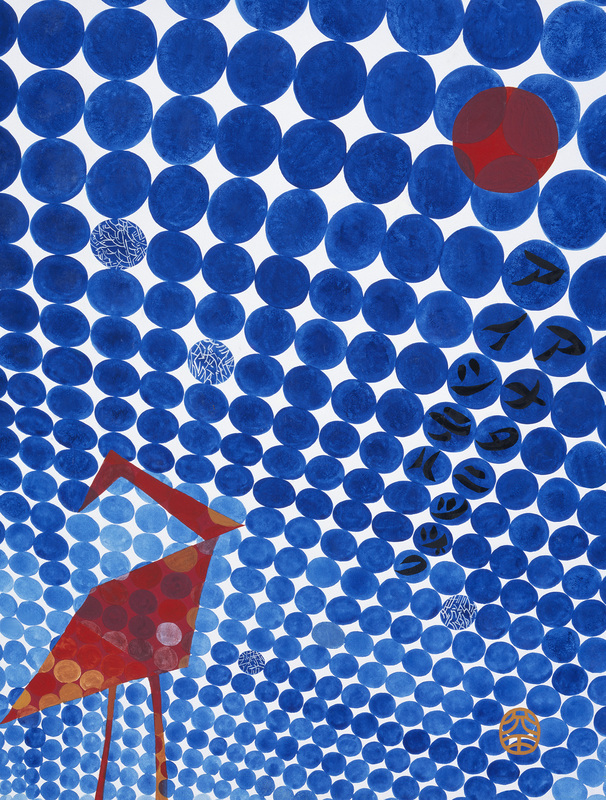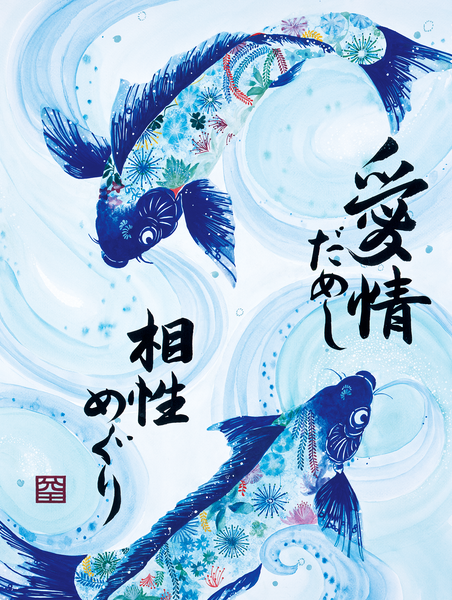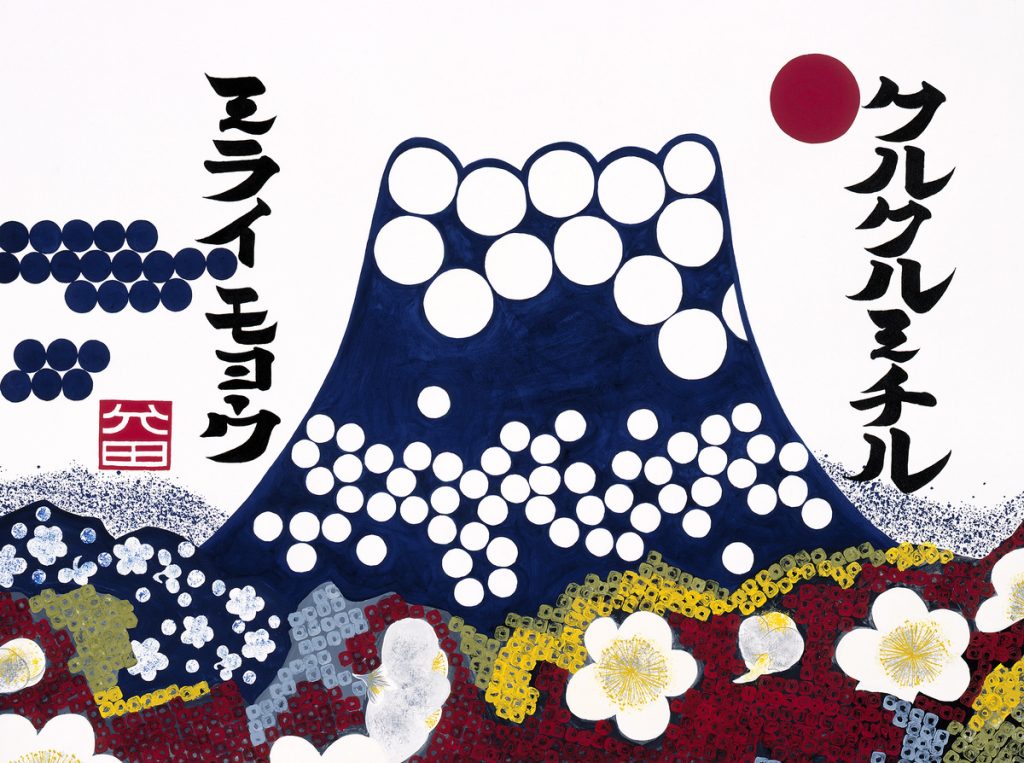All Images ©Rie Takeda
Your art is described as ‘Neo Japonism’ – could you share what this means to you, and how it reflects your work?
Rie Takeda: In short, Neo Japonism is fusing the essence of traditional calligraphy, Japanese design and poetry with contemporary art forms.
As well as the essence of traditional Japanese artisan, this style has two key essences which became the nucleus for my work. First, it consists of the flow of Japonisme-influenced art, especially by Paris and Vienna-based artists, since the 1870s. The second essence is the artworks of Taishō. The curiosity and boldness of artists experimenting with the new wave of the West and creating a fresh combination of colours, designs and hand lettering in that period. The momentum of these two crossing flows became the foundation for my process of combining and adding constant ‘here and now’ layers to my style. More fresh, momentum, pop and at the same time presenting an atmospheric spirit, particularly a warm nostalgia. This continuity of time and spiritual existence is what I’d like to evolve in my work.
You first started practicing calligraphy as a child under the creative guidance of your grandmother, a renowned calligrapher in your native Japan. Did you always know from a young age that you would pursue a career in art, and how has your career developed over the years?
RT: No, I did not know from a young age, although I was aware that I enjoyed Shodo and painting very much. As a child, Shodo, calligraphy and art were always different things until I got into illustration and Manga art at high school. After my studies, I kept on practising and teaching calligraphy, and began to combine my own colour work with calligraphy. During that experimention time, the vision of living as a freelance artist became clearer.
As for my career, I’ve been lucky to have worked and collaborated with many interesting teams and talented people; that’s been a key element. I always learnt and experimented with new techniques and ideas, it very much let me mature as an artist.
Whilst you are perhaps best-known for your Japanese calligraphy, your work is often interdisciplinary as you also specialise in collage, illustration and body art. How did your bold and contemporary trademark style evolve?
RT: I guess because I wanted to experiment with layers of warm nostalgia by bridging traditional techniques, like calligraphy, sumie, kirie, metaphor, symbolism and the present momentum pouring in me. I was consciously balancing and emphasising the co-existing aspects of these two, like old-new, life-death, active-still, light-shadow, yin and yang, traditional and modern. I evolved the contemporary style by challenging and observing this impermanent, co-existing point in everyday life.
As well as the different mediums, has the interculturalism of living, studying and working in different countries influenced your art?
RT: Definitely a big yes. It made me question lots more and seek for deeper insights about both technical and historical background, such as symbolism and metaphor in many Japanese art forms, during the creative process. Also, analysing the differences between Japanese art and art in Europe, and the rest of the world, opened up a fresh input and fully inspired me.
 PS I love you
PS I love you Love Chemistry in Enso Blue
Love Chemistry in Enso Blue
Limited travel has impacted opportunities for cultural exchange and artistic collaboration, are there any other ways in which the COVID-19 pandemic has affected your work?
RT: Firstly, I have reflected on what I’ve done and created in the past 20 years, and crystallized what I love and what I’d like to experiment with in the coming months and years as an artist. The pandemic made me rediscover the vital element of capturing the momentum and diving deeper into the details of calligraphic forms with sumi ink and brush. I especially enjoyed every step of how I develop the character into abstraction in various ways. And I’d like to transform it into a different medium this year. Overall, yes – it was, for me, a positive effect.
We often ask our interviewees for advice on how one can take up art. From your experience of establishing the successful School of SHODO, do you have any tips for those interested in learning more about Japanese calligraphy?
RT: My tip is to focus on the process of learning SHODO rather than the result, as you practise.
Avoid learning SHODO by yourself with books.
Become aware of body and mind connection.
Be in the present moment.
Your 2019 exhibition at Sway Gallery London, ‘PAINTED POEMS – 絵詩’, blended the graphic lines of calligraphy with rich painting and symbolic Japanese poetry. What was the inspiration behind this series?
RT: The theme for this exhibition was ‘Now and Then – Here and Now’. The inspirations are: an embrace of unified harmony as WA 和 (as a result of interlacing the two elements, old-new). Also, a natsukashii feeling – a warm nostalgia paired with the momentum of the here and now.
Your work has crossed over into fashion and lifestyle through collaborations with Kin by John Lewis and Desmond and Dempsey, too. How did these collaborations come about?
RT: They appreciated my art works first, both calligraphy and the painted poems series. So, the inspiration for these collaborations followed up as a result. And I had a great time developing the art works into prints.
As well as poetry and fashion, who, or what else, influences you as an artist?
RT: I’ve got so many! Classic calligraphy, Ukiyo-e and the ‘floating world’, Japonisme-influenced art (especially by Paris/Vienna-based artists), antique Kimono, the art of Taishō (1910-20s), and Gutai (late 1950-70). As well as everyday living words, sounds and letters, living colours, lines, patterns, and shapes in nature. Lately I’m inspired by Beatrix Ost’s approach towards ‘art’.
Finally, do you have any recommendations on little-known Japanese culture for our readers?
RT: I am sure your readers are well-versed. Apart from the art of Shodo, check out the Haniwa figures from the Kofun period, and the fantasy illustrations and prints from the Edo period are so unique and aspiring. Plus, ‘wabi-sabi’ as a comparison with (middle) modernism.
